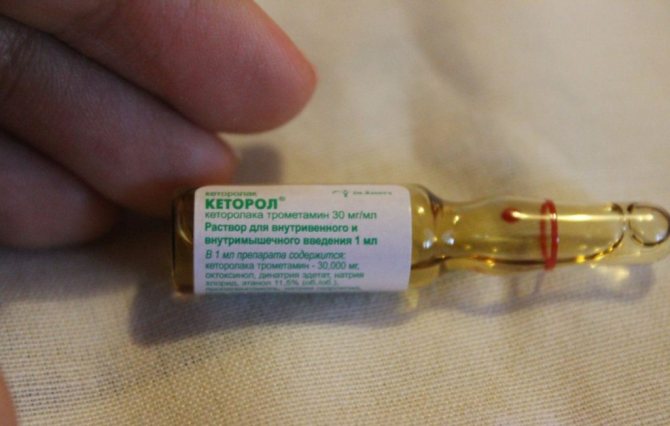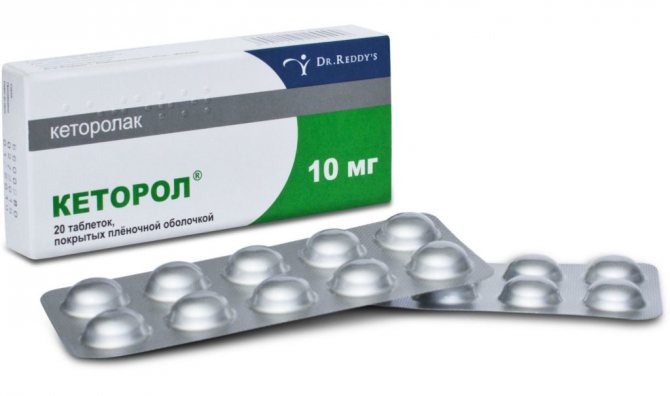Suffering from a toothache or headache? Often, choosing a drug for pain relief is not difficult. But what about during lactation? After all, not all medications are approved for use. Is it possible to use Ketorol while breastfeeding or is it better to find another remedy?
Ketorol can be used by a nursing mother only in an emergency, in the absence of approved painkillers on hand.
Is it possible to take painkillers for breastfeeding?
Almost every woman who breastfeeds asks herself this question.

Some continue breastfeeding until the baby is three years old, and some even longer. It is simply impossible for absolutely nothing to get sick over such a long period of time. Many people try to endure it for the sake of the baby’s health, which is not always safe. Therefore, in some cases, painkillers for breastfeeding are simply necessary. Not all medications have harmful effects. But each of them is absorbed into milk and will definitely end up in the baby’s fragile body. It is much easier when milk is no longer the child’s only food. After six months, complementary foods are actively introduced into the baby’s diet, and therefore some feedings can be replaced with formula or the milk can be expressed in advance, before taking the pills. But what if the baby was recently born? In this matter, of course, it is better to consult a doctor. However, there is a list of products, a single use of which will not cause much damage. We'll talk about this later.
Tooth pain
Probably the most unbearable pain is toothache. A young mother has no time to run to the doctor. There are situations when there is simply no one to leave the child with, so you have to solve the issue of painkillers on your own. Before you decide to take any medicine, be sure to read the instructions. It is possible that the chosen remedy is strictly contraindicated during breastfeeding. A medication that will help relieve tooth pain is Ibuprofen. In addition, it is a good antipyretic medication.

Every young mother's first aid kit contains fever remedies for her baby. The most common is Nurofen syrup. It is made on the basis of Ibuprofen, only in a dose adapted for the child. A nursing mother can take this medicine. But this will only relieve the pain for a while. The issue of going to the dentist should be resolved in the near future. What painkillers for breastfeeding can still be taken for toothache? This includes, for example, “Ketorol”. It is practically harmless. However, taking this medicine should not be systematic.
What should you do if you need to have anesthesia at your dentist appointment? After all, treatment, and especially removal, is almost impossible to endure without local anesthesia. Then the doctor will offer mommy a painkiller injection. GV allows the use of "Lidocaine" or the more modern "Ultracaine". Usually the dosage of the medicine is so small that it will not harm the child.
Method of using painkillers
You should not think that a single use of a painkiller can cure an existing disease. The use of such medications will only help alleviate the physical condition, but the cause of the pain will remain the same, so before taking a painkiller, you should find out how to use it correctly. The basic tips are simple:
- it is necessary to find out the cause - tooth, head or stomach, visit the appropriate doctor to prescribe treatment and the right medications;
- take only recommended medications - the detailed annotation for the drug must contain a phrase that is allowed during pregnancy and lactation, or that there are no contraindications for use during this period. It is also worth taking targeted medications - do not take any painkillers for muscle pain, but use special ointments;
- during breastfeeding, it is better to choose medications for single use;
- use the drug only in the recommended amount - it is not correct to reduce the dosage on your own in order to protect the child, the pain may not subside from this, and particles of the drug will still get into the baby;
- adhere to the required half-life of the medicine - it is better to take the medicine after feeding and before the baby goes to bed, so the components of the drug will have time to be absorbed and excreted from the body in time.
During the period of breastfeeding, you should not leave everything to chance or act at the last moment. Even during pregnancy, it is worth consulting with your doctor about approved medications and painkillers. Such drugs should definitely be on hand for a nursing mother. There is no need to endure pain - this in itself is already stressful for the mother, and there is no need for this if there are medications approved for breastfeeding.
Ketorol during lactation
Currently, therapists strongly advise women during lactation to use Ketorol with great caution. According to the instructions, taking this drug while breastfeeding is completely prohibited. Moreover, pregnancy and lactation are among the main contraindications to the use of such a remedy. Therefore, sensible women should not risk the health of their child. After all, Ketorol passes into breast milk. This will negatively affect the liver, nervous system, and blood-forming organs of the baby.
Even in minimal quantities, the active ingredient of the drug will poison the child’s body with a single dose of painkiller. This is due to the fact that in infants the metabolism is not clearly established. In addition, it is important to note that Ketorol will not be excreted from the child’s tissues.
It should be understood that before using any painkillers, it is advisable to carefully read the instructions. Strong drugs should not be used without the consent of a doctor. Nursing mothers are no exception in this regard.
Acceptable painkillers
Safer medications that eliminate pain include No-Shpa, Ultracaine, Lidocaine, Ketanov. However, when breastfeeding, it is still better to pay attention to analgesics from the group of non-steroidal drugs. These include Naproxen, Ibuprofen, Ketoprofen. They relieve pain and relieve inflammation. However, only a single dose of such drugs is allowed. For toothache in a nursing mother, Lidocaine or Ultracaine can be used for anesthesia.
But nursing mothers should completely forget about Citramon, Aspirin, Analgin, as well as its derivatives - Pentalgin, Tempalgin, Sedalgin. Their use is strictly prohibited. Moreover, analgin-based products are the strongest allergens. They negatively affect the functioning of the child’s liver, kidneys, heart, and nervous system.
If severe toothache haunts you in the evening, and you only have Ketorol on hand, then a single dose of the drug is allowed. True, you will have to skip at least two breastfeedings. They will need to be replaced with complementary foods or an adapted formula.
In case of serious illnesses, when painkillers are indispensable, the child is transferred to artificial feeding. The mother is prescribed full-fledged therapy using potent drugs. The dosage and features of administration are selected by the doctor after the examination.
Headache

This is another common ailment that can overtake a woman while breastfeeding. After childbirth, the body comes to its senses, and the hormonal system is rebuilt from pregnancy to lactation. This may cause occasional headaches. It is better, of course, to try to do without medications. Try to take your baby for walks in the fresh air more often. If possible, sleep as much as possible, leaving the baby to the dad. Then the pain will probably disappear. But if nothing helps, and the headache turns into an unbearable migraine, then you cannot do without medication. First, you should try No-shpu. It is allowed to be taken during pregnancy, since the composition of these tablets is based on herbs. A situation may arise when pain in the head is caused by vasospasm. In this case, “No-shpa” is the best assistant. It is considered one of the most effective antispasmodics. In addition, this medicine will help with abdominal pain.
List

Pain can be of completely different origin and nature. In some cases it can be tolerated, but sometimes this is not possible. In such situations, you need to know a list that will tell you which painkiller is available for breastfeeding.
- "Paracetomol." In extreme cases, its use is permitted. It will relieve severe spasms and help alleviate the condition.
- "Ibuprofen." As mentioned above, this medicine is great for coping with pain. If it is caused by a high temperature, then Ibuprofen will lower it.
- "Ketanov." It has a pronounced analgesic effect.
- "Drotaverine". This is a cheaper analogue of the well-known “No-shpa”. Such medications are often used as painkillers (PA) during menstruation. They will relieve the spasm from the walls of the uterus, relax it, and the illness will go away.
We recommend reading: When does milk come in after a cesarean section, what affects it if it’s not there, how to maintain lactation, how to express?
Is Ketorol suitable for nursing mothers?
When breastfeeding, a woman must take full responsibility not only for nutrition, but also for her health. In this case, the baby will be guaranteed to grow and develop well.
However, acute pain can occur at any moment, which not only spoils the mood, but also prevents you from doing normal work caring for the baby and at home. To eliminate it, it is allowed to use only absolutely safe drugs. Their composition should not cause harm.
That is why every mother may have a question, is it possible to use Ketorol while breastfeeding?
What does it consist of and in what form is it produced?
The release form of Ketorol can be different - these are tablets, gel or solution for injections. The active substance in the drug is ketorolac. Additional components include: water, ethanol, glycerin, propylene glycol, tromitamine, food additives and others (depending on the form of release of the drug, the composition changes slightly). Injections help relieve pain within 30 minutes, and tablets begin to act within an hour.
Indications
Ketorol is a drug that is recommended to be used to eliminate the inflammatory process. It does not contain steroids, which can negatively affect the baby’s health. The main active ingredient is ketorolac.
It does not have a narcotic effect, but is able to eliminate severe pain and spasms within a short time. Thanks to this ingredient, it is possible to relieve inflammation and lower body temperature. A woman can feel the positive effects within an hour after taking it.
In some cases, relief comes much faster.
Ketorol is recommended for use to eliminate the following pathologies:
- severe pain, the nature of which has not been fully established;
- rehabilitation of the patient in the postoperative period;
- improving the general well-being of patients with cancer.
Additionally, it should be noted that the drug has a strong analgesic effect. Some doctors believe that the effect of the drug is similar to morphine. The doctor decides whether it is appropriate for breastfeeding mothers. The drug is not available without a prescription.
Tablets during breastfeeding can only be taken as prescribed by a doctor.
The instructions contain many side effects and contraindications. It also contains information that the drug should not be taken during pregnancy and lactation. The composition contains quite active components that negatively affect the composition of milk and the general condition of the child’s body.
Today, there are three dosage forms of the drug that are used as therapy by different patients. Their composition differs in several effective components. The choice of form depends on them:
- gel;
- pills;
- liquid that is used for injection.
Features of using the drug for hepatitis B
Can Ketorol be used during pregnancy and lactation? The instructions contain information that this process is not permissible. However, there are cases when it is impossible to do without this drug during hepatitis B.
During this period, the medicine can only be used with extreme caution. The components penetrate into the milk and can negatively affect its composition.
They interfere with the normal functioning of the liver, central nervous system and blood flow.
During lactation, it is allowed to take one tablet of Ketorol only after the approval of a doctor, who carefully analyzes the feasibility of the process. We recommend reading: Spasmalgon during breastfeeding
However, it should be understood that even 0.01 g of the active component leads to serious disorders in the child’s body. After taking it, some women not only lost pain, but also lactation itself. In this case, further treatment using Ketorol is considered impossible. Among the side effects, you should pay attention to the following manifestations:
- deterioration or complete disappearance of milk production;
- the active ingredients of the drug will negatively affect the baby’s body;
- serious pathologies of the liver and central nervous system;
- jaundice.
These are only the main negative effects that are recorded while taking the drug. To date, its negative effects have not yet been fully studied. That is why it is recommended to replace it with a safer medicine.
Not every pain is recommended to be eliminated with the help of drugs. For example, during menstruation, cramps subside as soon as the baby begins to breastfeed. The situation improves as hormones enter the body, which have a positive effect on the mother’s condition.
If taking Ketorol is unavoidable, then the woman is advised to express and freeze the milk in advance or transfer the baby to an artificial feeding option. All components are eliminated from the body within three meals.
Ketorol should not be taken during pregnancy and breastfeeding.
Therapeutic effect and what can replace the remedy?
Most of all, Ketorol has an analgesic effect. There are also anti-inflammatory and antipyretic effects, but they are rather poorly developed. For these purposes, it is better to use Paracetamol. Ketorol during breastfeeding can be replaced by drugs with ibuprofen if a woman has pain in the lower abdomen, head or tooth. You can take Nurofen or MIG, or use safe products - No-shpa or Drotaverine.
We recommend reading: Pads for women in labor: which ones to take to the maternity hospital, sterile models after childbirth, how to use them
Pharmacological group
Ketorol is a fairly powerful and effective pain reliever. It is recommended to drink it to eliminate inflammation and quickly lower body temperature. When the active components penetrate the body, cyclooxygenase enzymes are blocked.
This version of enzymes is involved in any inflammation and increases body temperature. The drug helps relieve pain within a short time. Thanks to this, the patient begins to feel much better.
While taking the medicine, it noticeably thins the blood, so the likelihood of bleeding increases. Ketorol should not be used for a long time, as it leads to the formation of ulcers in the digestive system. The maximum course of treatment should not exceed thirty days. This period should be shortened as much as possible during lactation.
Contraindications for use
- Diseases of the bronchi and upper respiratory tract.
- Swelling.
- There is a decrease in blood volume in the body.
- Severe dehydration.
- The presence of pathologies in the gastrointestinal tract.
- Low blood clotting.
- The liver and kidneys are not functioning properly.
- Previously there were hemorrhages in the brain.
- Concomitant use with other non-steroidal drugs is not allowed.
- A woman is pregnant or breastfeeding.
- The child is under 16 years of age.
- There is increased sensitivity to individual components.
Kidney damage occurs when combined with Paracetamol.
When using other means during the course of treatment, it is recommended to consult a specialist in this field.
Ketorol is a drug that is prohibited during lactation. That is why it is recommended to replace it with safer analogues. In this case, it will be possible to maintain the health and normal development of the baby. Otherwise, it is necessary to transfer the child to an artificial feeding option.
Is the use of the drug allowed after a cesarean section?
To relieve pain after surgical childbirth, women in labor are often prescribed Ketorol. With its help, women who have undergone surgery can quickly and effectively relieve pain. A woman’s breast milk appears a little later after a cesarean section than during a natural birth, so the risk of harming the baby’s health is much less, because adverse reactions cannot occur in the baby.
How to take Ketorol safely
The instructions for the drug contain information about the recommended course of taking the drug - it is no more than five days and no more than 4 tablets per day. This information is about the maximum dosage, but a breastfeeding woman is allowed to take a much smaller number of tablets.
The annotation itself states that taking the drug during lactation is contraindicated.
But doctors sometimes allow a nursing woman to take Ketorol, believing that a single use of the drug will not cause serious harm to health.

All forms of Ketorol are unsafe for a nursing mother during long-term use.
The same opinion is shared by foreign pharmacists who claim that the main active ingredient in the drug, ketorolac, is compatible with breastfeeding. With a single dose, only a small part of it penetrates into breast milk, which does not cause harm to the baby. At the same time, you should not self-medicate, because any medication for guardianship should be prescribed by the attending physician.
Depending on the nature of the pain and the available indications in each specific case, the doctor prescribes the required dosage of the drug in tablets or injections and a possible treatment regimen.
Ketorol gel is usually used for topical application for injuries, after a bruise or sprain. The drug is smeared onto the previously cleaned surface of the skin in a fairly thin layer. In this case, application is possible no more than 4 times a day, and the minimum break between applications is four hours. The period of use of the gel is slightly longer - up to 10 days.
It is in vain to think that Ketorol in gel form is completely safe during breastfeeding.
The components of the drug still penetrate into mother's milk, so even when using the gel, you should not breastfeed your baby for at least 2, and if possible 4, hours. A nursing mother, even before using the product, should take care of the baby and express milk if feeding is planned much earlier than the required time.
Presence of side effects
Among the adverse reactions of the body to the use of the drug, allergies are distinguished. It can develop quite severely, even to the point of swelling of the larynx or breathing problems. Also, taking the drug may be accompanied by problems with the functioning of the kidneys or organs of the urinary system.
It is also possible that you may develop headaches, drowsiness or dizziness. In rare cases, side effects include hallucinations, problems with vision and hearing, excessive anxiety, meningitis, seizures, or mental instability. As a result of using the drug, blood pressure may increase or pulmonary edema may occur.

If any reactions are noticed when using Ketorol, it is better to stop taking it and consult a doctor.
In case of problems with the respiratory system or swelling of the larynx, it is recommended to take an antiallergic drug, such as Zodak, Loratadine or Suprastin, and immediately call an ambulance.
Presence of contraindications
Contraindications to the use of the drug include:
- Presence of bronchial asthma.
- Development of polyposis in the nose or paranasal sinuses.
- Ulcer or erosion of the stomach.
- Development of bleeding in the stomach.
- Exacerbation of the inflammatory process in the intestines.
- Liver-related diseases and liver failure.
- Kidney failure.
- Hemophilia or lack of good blood clotting.
- Hyperkalemia.
- Lactose deficiency or intolerance.
- Heart failure.
- Individual intolerance to the main active ingredient – ketorolac.

Despite the lack of recommendations for the use of Ketorol during breastfeeding in the instructions, doctors recommend it as an emergency aid in the event of acute pain, but only for one-time use. In all other cases, it is better to use other medications, for example Paracetamol if you have a fever, or Ibuprofen if you have a toothache or headache.
Precautionary measures
Ketonal, like any medicine, has a number of contraindications:
- Hypersensitivity to main or excipients;
- Aspirin asthma;
- Ulcer;
- Ulcerative colitis;
- Diverticulosis;
- Chronic inflammation of all parts of the gastrointestinal tract;
- Impaired hemostasis;
- Chronic kidney diseases.
As stated in the instructions, Ketonal is prohibited for children under 14 years of age, pregnant and nursing mothers.
Under the supervision of a doctor, people suffering from bronchial asthma, anemia, alcoholism, and cirrhosis take the drug. This limitation applies to patients with functional insufficiency of the liver, kidneys, diabetes mellitus, and hypertension. Use the drug with caution for edema, stomatitis, and blood diseases.
Sometimes side effects occur after taking the medication:
- epigastric pain, nausea, vomiting, stomatitis, etc.;
- headache, irritability, sleep and speech disorders;
- hypertension, increased heart rate;
- disturbances of vision, hearing or taste;
- rash, shortness of breath, runny nose, Quincke's edema.
If the above or other symptoms appear, stop taking the drug and consult a doctor.
Contraindications and side effects
The instructions for the drug contain a large list of contraindications:
- the possibility of individual reaction to the components;
- asthma (including bronchial);
- congenital lactose intolerance, acquired lactose deficiency;
- cardiovascular abnormalities;
- gastrointestinal diseases (peptic ulcer, colitis, bleeding of various kinds);
- kidney problems;
- tendency to allergic reactions.

It is forbidden to take Ketorol together with Aspirin (this can cause serious problems with the liver of the mother and child), as well as a number of other medications:
- Valproic acid (drugs that neutralize epilepsy attacks and help with migraines). A one-time dose with Ketorol can lead to intense bleeding and cerebral hemorrhage. Thrombolytics and anticoagulants can have the same effect.
- Muscle relaxants (for muscle spasms) together with ketorolac cause shortness of breath.
- ACE inhibitors may impair kidney function.
- A number of psychotropic drugs in combination with Ketorol cause hallucinations as consequences.
Pregnancy and breastfeeding are one of the contraindications. The components of the drug penetrate into the milk, having a negative effect on the baby’s body. Ketorol should not be given to children under 16 years of age.
Possible side effects include:
- disruption of blood flow in the child’s body;
- damage to the central nervous system;
- negative impact on liver function;
- problems with the urinary system;
- hypertension;
- difficulty breathing (Quincke's edema).
At the first signs of a complication, you should immediately stop taking Ketorol and consult a doctor. In cases of allergies (redness of the skin, itching, swelling of the larynx), you should immediately take an antihistamine and call an ambulance.

How does breastfeeding affect lactation and the child?
The use of the drug during breastfeeding does not directly affect the quality of lactation.
However, the individual reactions of a woman’s body can be unpredictable. It is possible that anesthesia, having a relaxing effect on the female body, will have a positive effect on the quantity of milk or will not affect it at all, but its quality will definitely be worse. Cases where milk disappeared after taking Ketorol have not been described, so it is worth thinking more about the effect on the child’s body.
The drug, entering the baby’s bloodstream with milk, poisons his body , since the metabolic process in young children has not yet been established, and therefore the chemicals are retained, poorly excreted by the kidneys and insufficiently neutralized in the liver.
Ketorol, getting into the blood, can cause disturbances in the baby’s central nervous system and problems with hematopoiesis. All this, of course, harms the child.
Features of application
Ketorol is an anti-inflammatory non-steroidal drug with analgesic properties. The active substance of this drug is ketorolac. This remedy provides a moderate antipyretic effect. Ketorol relieves inflammation and eliminates pain. This analgesic helps suppress cyclooxygenase activity in peripheral tissues. There will be no drug dependence from taking the drug.
The action of Ketorol is compared with morphine. The medicine is superior to many other anti-inflammatory medications of various categories. After its administration intramuscularly, the analgesic effect begins within half an hour. Taking the tablet form gives effect within an hour.
Ketorol allows you to relieve pain syndromes of various origins. However, before using this drug, it is important to become familiar with its side effects. It should be immediately clear that there are many of them. These include lower back pain, acute renal failure, thrombocytopenia, increased urine output, swelling, constipation, and diarrhea.
The nervous system also suffers. Its damage can manifest itself as depression, dizziness and migraines, ringing in the ears, blurred vision and nervousness leading to psychosis.
In some cases, bronchospasms, dyspnea, and laryngeal edema occur. Allergic reactions in the form of hives, rashes, and itching are also possible.
Recommendations for use in breastfeeding mothers
A nursing mother can take 1 tablet of Ketorol for severe pain, but only after the doctor's approval. This means a dose of 0.01 g of the drug, but even this is enough to disrupt the functioning of the baby’s body .
An ampoule of Ketorol contains 1 ml of the active substance, so the effect is the same, but it enters the bloodstream faster.
If the mother has received doctor's approval to use Ketorol, she must first express several portions of milk (provided, of course, that the mother has enough milk). Then take the indicated painkiller, but after that you will have to skip three feedings until the active substance is removed from the body. Expressed milk is useful for these feedings. If it is not enough, it is still safer to feed the baby with an artificial formula, but take a break of three feedings.
Reminder! Do not forget that Ketorol cannot be used with aspirin, as well as non-steroidal drugs.
What painkillers can you take while breastfeeding?
When choosing painkillers, you should remember that the properties of most of them have not been fully studied, but those that are acceptable for use still, to one degree or another, pass into breast milk. Therefore, for the safety of the child, it is better for a nursing mother to first express the milk and leave it for later feeding of the baby, and only after that take the medicine. But there are situations when the baby only takes the breast and refuses the bottle; in this case, the least dangerous medication for him should be used.
We recommend reading: Polygynax during breastfeeding, treatment with suppositories during breastfeeding

When breastfeeding, you should choose the safest and most proven drugs
Before choosing a drug with an analgesic effect, it is necessary to evaluate the following indicators:
- in what quantity the substance passes into breast milk;
- how it affects the body of mother and child;
- how quickly the drug is removed from the mother’s body - in this case, it will be possible to minimize the risks by feeding the baby when the concentration of dangerous substances in the body is the lowest;
- how long can you take the medicine without negative consequences for mother and child.
During breastfeeding, the safest painkillers are Paracetamol and Ibuprofen, as well as their analogues. Even when taking high dosages, these substances pass into mother's milk in minimal quantities.
Table: drugs allowed for use during breastfeeding
| Name of the drug | Paracetamol, Panadol, Efferalgan | Ibuprofen, Nurofen. | No-shpa | Naproxen | Ketoprofen |
| Efficiency | average | average | average | average | average |
| Active substance | paracetamol | ibuprofen | drotaverine hydrochloride | naproxen | ketoprofen |
| Exposure period | maximum concentration is achieved after 30–120 minutes | maximum concentration is achieved after 45 minutes (when taken on an empty stomach) or after 90–150 minutes (when taken after meals) | maximum concentration is achieved after 45–60 minutes | maximum concentration is achieved after 2–3 hours | the maximum concentration is reached after 1–5 hours, depending on the form in which the drug is released |
| Action | it is applied for:
| it is applied for:
| applies:
|
|
|
| Side effects and restrictions |
|
|
|
|
|
| Main contraindications |
|
|
|
| serious diseases of the gastrointestinal tract, liver, kidneys |
| Effects during breastfeeding | less than 1% of a single dose passes into breast milk and is excreted in a concentration of 0.04–0.23% | approximately 0.6% of a single dose passes into breast milk | there is no clinical data on the effect of the drug on a child during lactation | low penetration into ore milk | low penetration into breast milk |
| Conclusion | Can be used during lactation, but not often | during lactation, do not use for a long time at a dose of more than 800 mg per day | due to insufficient information about the effect on the child, taking the drug should be justified: only in one-time cases and with the permission of a doctor | Can be taken during lactation, but with caution, in one-time cases | a one-time dose is possible, but if used for a long time, lactation should be stopped |
Indications for use
Ketorol is a powerful drug that is barely weaker than morphine. Once in the blood, the components block the action of cyclooxygenase enzymes. The medicine is used for postoperative recovery, reduces temperature, but its main purpose is analgesic. The medication neutralizes pain even at high intensity and is used to relieve pain in cancer patients.
Important! Patients notice the effect of the medicine within 30-60 minutes after administration, and sometimes almost immediately.
Ketorol is especially effective in a number of cases:
- pain after limb injuries (dislocations, fractures, sprains);
- neuralgic pain;
- myalgia of various etiologies;
- arthralgia;
- toothache;
- relief for women after childbirth (including caesarean section).
Ketorol is available in three forms: gel, tablets and solution for injection. During lactation, uncontrolled use of ketorolac in any form is not allowed; drugs with this active substance must be prescribed by a doctor.











